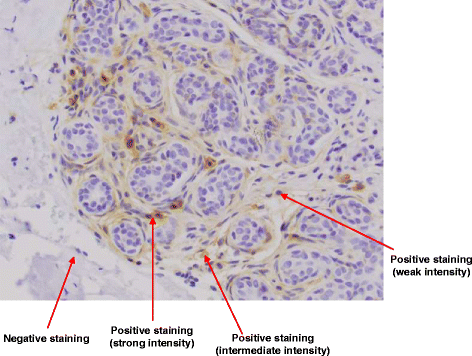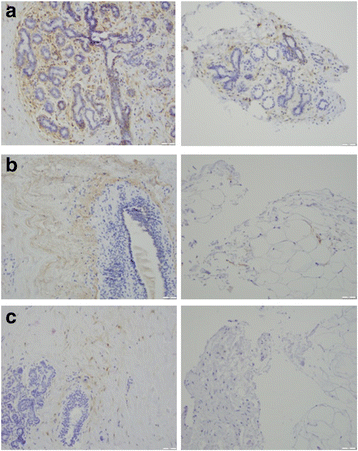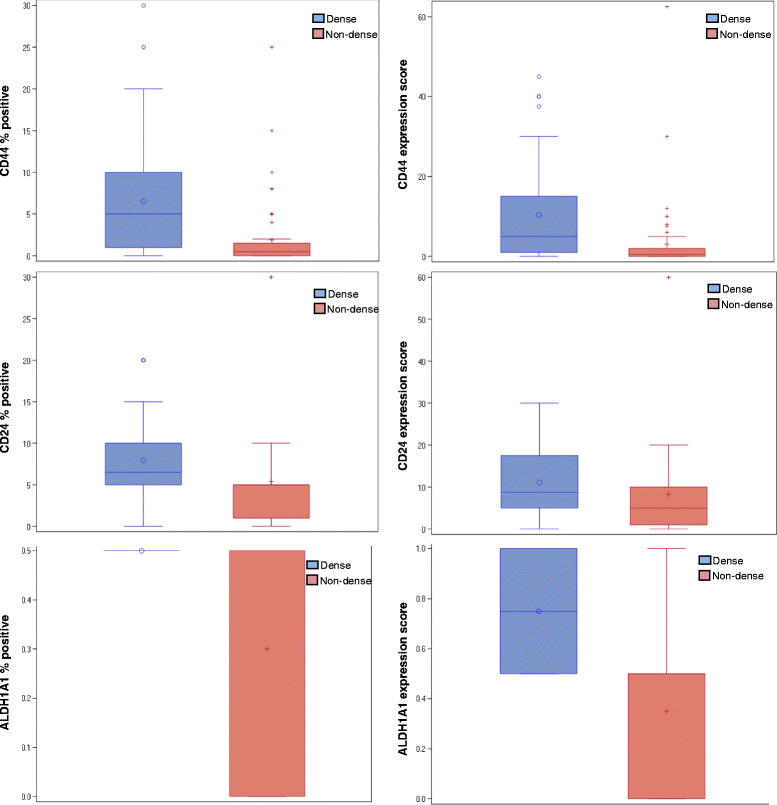Tissue-based associations of mammographic breast density with breast stem cell markers
- PMID: 28851411
- PMCID: PMC5576318
- DOI: 10.1186/s13058-017-0889-3
Tissue-based associations of mammographic breast density with breast stem cell markers
Abstract
Background: Mammographic breast density is a well-established, strong breast cancer risk factor but the biology underlying this association remains unclear. Breast density may reflect underlying alterations in the size and activity of the breast stem cell pool. We examined, for the first time, associations of CD44, CD24, and aldehyde dehydrogenase family 1 member A1 (ALDH1A1) breast stem cell markers with breast density.
Methods: We included in this study 64 asymptomatic healthy women who previously volunteered for a unique biopsy study of normal breast tissue at the Mayo Clinic (2006-2008). Mammographically identified dense and non-dense areas were confirmed/localized by ultrasound and biopsied. Immunohistochemical analysis of the markers was performed according to a standard protocol and the staining was assessed by a single blinded pathologist. In core biopsy samples retrieved from areas of high vs. low density within the same woman, we compared staining extent and an expression score (the product of staining intensity and extent), using the signed rank test. All tests of statistical significance were two-sided.
Results: A total of 64, 28, and 10 women were available for CD44, CD24, and ALDH1A1 staining, respectively. For all three markers, we found higher levels of staining extent in dense as compared to non-dense tissue, though for CD24 and ALDH1A1 the difference did not reach statistical significance (CD44, 6.3% vs. 2.0%, p < 0.001; CD24, 8.0% vs. 5.6%, p = 0.10; and ALDH1A1, 0.5% vs. 0.3%, p = 0.12). The expression score for CD44 was significantly greater in dense as compared to non-dense tissue (9.8 vs.3.0, p < 0.001).
Conclusions: Our findings suggest an increased presence and/or activity of stem cells in dense as compared to non-dense breast tissue.
Keywords: Breast cancer risk; Breast density; Immunohistochemistry; Staining extent; Stem cell markers.
Conflict of interest statement
Authors’ information
No further information.
Ethical approval and consent to participate
This study was approved by the Mayo Clinic, Rochester and the University of Florida Institutional Review Boards. Written consent was obtained from all participants.
Consent for publication
Not applicable.
Competing interests
The authors declare that they have no competing interests.
Publisher’s Note
Springer Nature remains neutral with regard to jurisdictional claims in published maps and institutional affiliations.
Figures



References
-
- Vachon CM, Sellers TA, Vierkant RA, Wu FF, Brandt KR. Case-control study of increased mammographic breast density response to hormone replacement therapy. Cancer Epidemiol Biomarkers Prev. 2002;11(11):1382–8. - PubMed
MeSH terms
Substances
Grants and funding
LinkOut - more resources
Full Text Sources
Other Literature Sources
Medical
Miscellaneous

